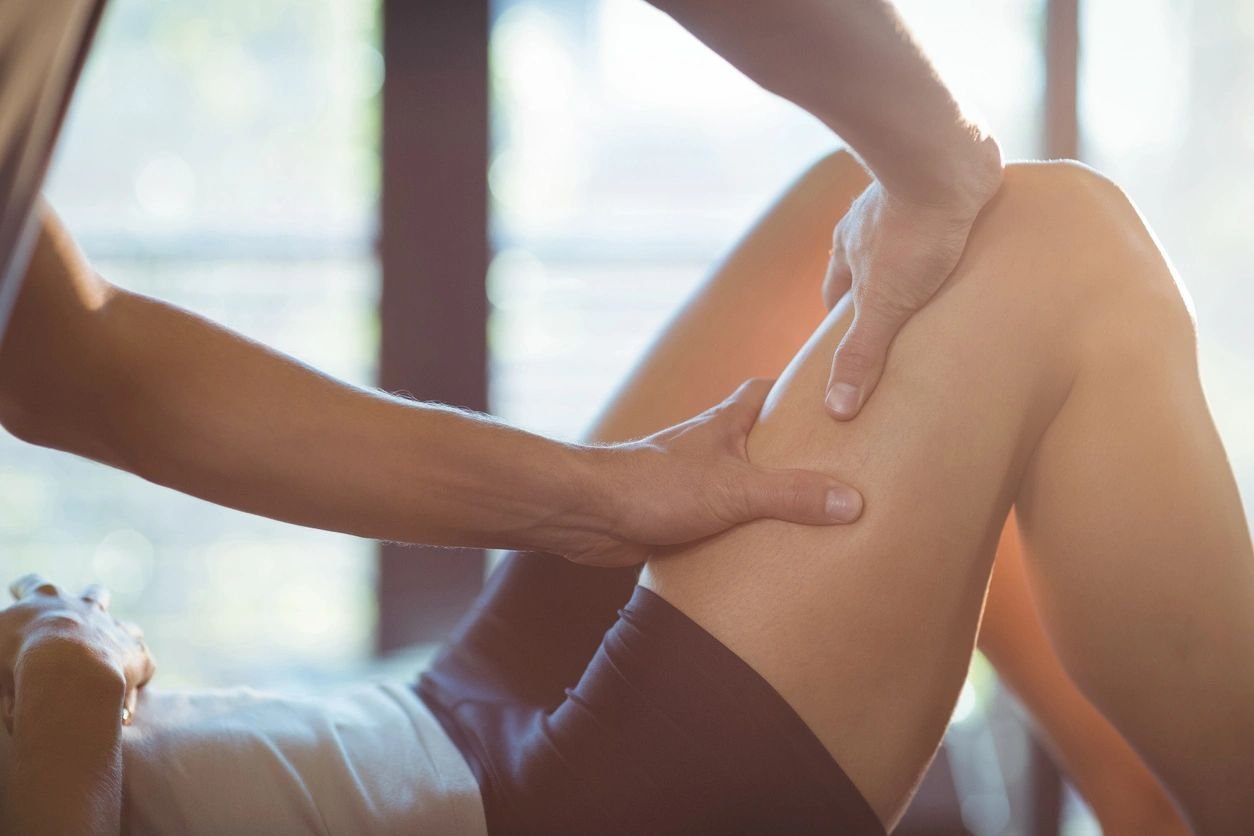Hip Pain: Definition, Yoga, Chiropractor
Hip Pain is a relatively common issue that can significantly restrict a person’s ability to move around. Hip Pain is one of the most common medical conditions, impacting about half of all adults at some point in their lives. While hip pain is often associated with aging, it can also be caused by an injury or imbalance in the muscles of the lower body.
In this article, we will discuss some of the most common therapies for hip pain, and we will also provide some ideas on how to choose the treatment that will be the most beneficial to you.
What is Hip Pain
“Hip pain” can refer to various kinds of discomfort, all of which start in or around the hip joint. When you press on the area around your hip physically, it’s possible that you won’t feel any pain coming from your hip at all. This is a possibility. There is a chance that you will feel discomfort in your groin, as well as in your thighs or knees. In addition to this, there is a chance that you will feel Pain in the region of your lower back. This is something that you should be prepared for.
To begin, you should ensure that you are doing all in your power to lower the inflammation that is most likely the source of your discomfort. This should be your primary focus as you work to treat your condition. This includes refraining from activities that aggravate the affected area and using pain relievers, such as ibuprofen or other medications, as prescribed by your medical professional.
Second, you should seriously consider taking part in some physical therapy to assist in regaining your hip’s flexibility and range of motion. In addition to the amount of discomfort you feel diminishing as a consequence, you will also experience an increase in your general mobility.
Last but not least, you must converse with your primary care provider about any additional treatment possibilities. These can include going through surgery or taking specific vitamins to help minimize the severity of your difficulties.
Hip Pain Yoga
If you are experiencing hip Pain, there is a good chance you need some yoga to help ease the pain and help you get back to your normal routine. Yoga has been known to help with various ailments, including hip pain. Research has found that hip pain yoga can help improve joint range of motion and reduce inflammation. Plus, it can also help improve mental well-being and overall fitness.

So if you are struggling with hip pain, give hip pain yoga a try as an option for relief. This is a reliable treatment option for the treatment of those who suffer from inflammation and musculoskeletal Pain. The massage technique is myofascial release and has been around since the 1960s. With this technique, you can fully stretch out your muscles so that they can recover and heal quicker. If you have lumbar disc issues, you don’t want to try this, but it could be beneficial if you have mild hip flexor problems or other types of body pain.
Hip Pain Chiropractor
Hip Pain is a widespread issue that can afflict anyone at any time. The cause of hip pain can vary, but it is usually caused by something pressing on the hip joint. If the hip is not aligned properly, the pressure can cause inflammation and Pain. Hip pain chiropractors are skilled in treating hip pain with adjustments and massage. They might also prescribe painkillers to help alleviate the discomfort you’re experiencing.
Hip Pain External Rotation
External rotation of the hip is a common complaint. Various conditions can cause this, but most often, it is due to arthritis. Hip pain external rotation can also be caused by:
- – A tear in the adductor muscle tendon
- – A fracture of the femur
- – Pelvic fracture
- – Tendonitis
- – Tearing of the hip capsule
- – Ligament problem
- – Hip joint osteoarthritis
- – Overuse injury with prolonged sitting or prolonged walking.
External rotation may also be caused by:
- – Postural problems
- – Ankylosing spondylitis (a severe form of arthritis)
- – A dislocated hip joint that is still in place after the muscles have withdrawn around it
- – A patellar tendon tear
Can Hip Pain Cause Sciatica
A disorder referred to as sciatica is defined by Pain that travels down the back of each leg to the foot, starting at the lower back and working its way up. It is unknown what causes sciatica; nevertheless, many different factors could contribute to the ailment’s development.
A herniated disc, degenerative disc disease, tight muscles, and a pinched nerve are some of the variables that might contribute to this condition. Sciatica can be caused by a variety of factors, including overuse and muscle spasms, which are two of the most prevalent. If you have any cause to believe you may be suffering from sciatica, seek medical advice. This will allow them to rule out other possible reasons and give you the most appropriate therapy.
Some treatments that may help reduce the symptoms of sciatica include painkillers, ice, medication to alleviate cramping, and anti-inflammatory drugs. Surgery is another therapeutic option that might be considered for certain patients with severe sciatica who cannot get relief from previous treatments.
What Is Sciatica?
Back pain caused by an issue with the sciatic nerve is called sciatica. This type of back pain can be quite excruciating. This significant nerve travels down the back of both legs, beginning in the lower back and ending in the front of the thighs. This is because the sciatic nerve is located in the back of the thigh. This Pain can be brought on by either an injury to the nerve or persistent pressure on the nerve for an extended time. A non-surgical treatment option can be effective for as many as ninety percent of sciatica cases without surgery.
Hip Pain and Sciatica
Hip Pain and sciatica are two common conditions that can affect the hips. Hip Pain is typically caused by a problem with the hip joint, a joint composed of a ball and socket that is found at the top of the thigh. Sciatica is a condition that affects the sciatic nerve, which runs down the back of the leg. Hip Pain causes many possible causes, and several different things can cause sciatica. Hip Pain and sciatica can be difficult to diagnose and treat, so it’s important to get checked out if you’re experiencing symptoms. If you have hip pain or sciatica, there are several things you can do to help improve your condition.
In order to alleviate hip Pain and sciatica, consider the following guidance:
- 1. Get checked out if you’re experiencing hip Pain or sciatica, discomforting muscle aches in your back or leg that won’t go away with rest or ibuprofen.
- 2. Make sure you’re wearing appropriate footwear when you walk or exercise. Wearing improper shoes can cause your hips to move uncomfortably, leading to hip pain.
- 3. Try using a foam roller or lacrosse ball to loosen tight muscles or help alleviate hip Pain.
- 4. If you have sciatic nerve pain, remember that sitting for long periods can aggravate the Pain.
- 5. Stretch and do some exercises to improve flexibility in your hips and legs, which will help relieve hip pain.
- 6. If your leg feels fine when standing up straight, and you don’t have any numbness or tingling but feel a significant amount of discomfort when you start moving around or bend forward, you likely have flat feet. In the event that this is the case, you should consult an orthopedist regarding the possibility of having surgical corrections made to your feet so they don’t cause as much stress on your hips and other body areas.
- 7. If you urinate frequently or your Pain is abnormally severe, your bladder may be wrong. This can lead to hip pain.
- 8. You should always see a chiropractor for back pain treatment because it will help relieve hip Pain and arthritis in other areas.
- 9. Certain medications or conditions can cause hip Pain for no apparent reason, such as rheumatoid arthritis (RA). If this condition is not under control, the context is as follows, then you may be able to relieve the Pain by adjusting your spine.
- 10. Pregnant women usually experience increased hip and back pain when carrying a child in their pelvis. This Pain doesn’t usually last too long, but it can be quite severe.
- 11. Problems with the sacroiliac joint can cause hip Pain. If this is the case, the discs in your pelvis are at risk, so you may need to have your chiropractor make a specific adjustment to the sacroiliac joints.
If you’re experiencing any hip pain, you should see your chiropractor as soon as possible to relieve it. Don’t wait too long because hip pain can lead to other problems, such as heart disease and arthritis in other parts of the body. As mentioned before, always seek treatment from a chiropractor specializing in hip pain, not just one offering general “adjustments.” That’s where things get complicated!
Hip Pain upon Walking
The information that you must be aware of regarding hip pain while walking. When walking, it’s not unusual to feel Pain in the hips, especially in older people. Pain in the hip can be brought on by various factors, such as damage to the muscles, tendons, bones, or nerves surrounding the hip, and degenerative conditions, such as arthritis. An examination of the individual’s hip pain with the assistance of a trained medical professional can help establish the nature of the issue and provide the necessary treatment.
It is not unusual to experience difficulty getting out of bed in the morning, particularly when you have only recently awakened from sleep. After all, the activities from the previous evening probably caused you to wake up with some muscle soreness and some stiffness. You try to stand up, but it feels like the Pain from your hip is spreading to other parts of your body too much for it to be worth it. If you have Pain in your hip when you walk, this potential outcome could happen due to the condition.
If you are having trouble walking, you should seek medical attention as soon as possible since people who have hip discomfort face worsening symptoms every time they move. If you are having trouble walking, you should get medical attention as soon as possible. If you are a person who has hip Pain, you must seek medical attention.
There are several different things that you can do while you are walking to alleviate the Pain that you are experiencing in your hip. One of these things is bending your knees slightly when you walk. To get started, give yourself a few moments to pause and deeply breathe in some air. As a result, you will most likely experience the same level of pain relief.
Wearing shoes that can adequately support your feet is the second piece of guidance that I have for you. When you walk, a significant amount of pressure is applied to your feet; to alleviate some of this stress, it is important to wear shoes that provide a good fit for your feet. Ensure you walk with the correct form as the last step in this process. You must remember that bending at the waist or slouching will only put additional strain on your hips, so it is best to avoid doing either of these things as much as possible.
If you have trouble walking due to hip pain, you should seek medical assistance as soon as you possibly can. Your physician can help you in determining the source of your hip pain and may also advise you on the treatment options that are most likely to help you ease your symptoms.
Conclusion
There is no one answer to the question of what hip pain means, as various causes can cause it. However, some general signs may indicate that hip pain is present, including difficulty moving around the hip joint, Pain while either sitting or standing, as well as an inability to conduct Activities of Daily Living (ADLs) such as climbing stairs or getting out of bed, are all possible. If you observe any of the following symptoms, it is important to seek medical attention to rule out any underlying causes.















